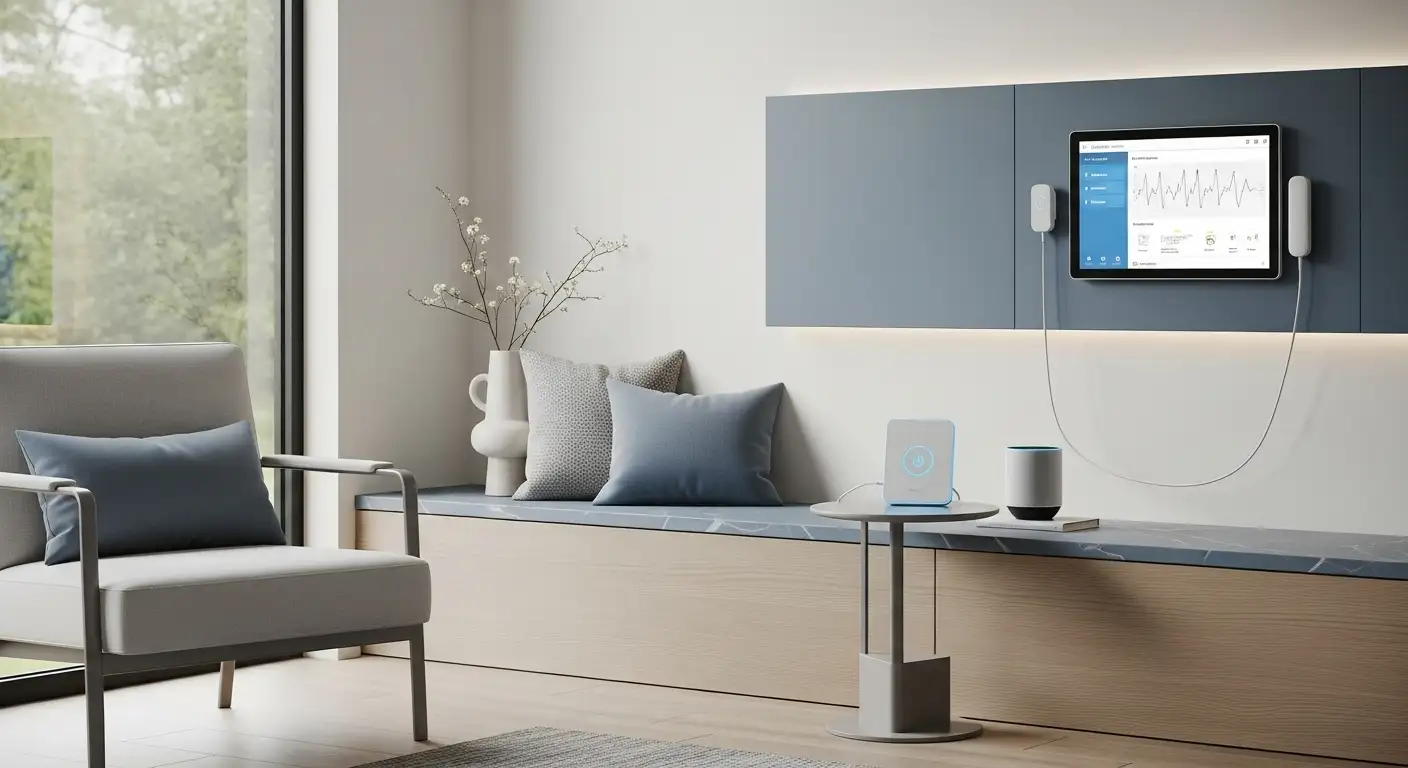Utilizing Technology in Elderly Care
Importance of Remote Caregiving Technology
As the population ages, the demand for home care is set to rise significantly. By 2020, approximately 120 million older Americans required care at home, resulting in around 45 million unpaid caregivers managing multiple aging family members. This situation has created an urgent need for effective solutions to support both caregivers and recipients. Technology plays a crucial role in addressing this demand by facilitating remote caregiving. This enables caregivers to deliver quality care from a distance while maintaining a connection with their loved ones.

Technological innovations improve in-home support by simplifying tasks such as health monitoring, communication, and record-keeping. Digital tools streamline the management of medical records and offer platforms for continuous assessment of health stats. This integration of technology in caregiving not only eases the burden on caregivers but also enhances the quality of life for older adults. For more insights on the challenges faced by the NHTD waiver program, refer to our page on NHTD waiver program challenges.
Evolution of Remote Caregiving with Digital Tools
Remote caregiving has undergone significant transformation due to advancements in technology. Digital tools have revolutionized the landscape of elderly care, allowing caregivers to engage efficiently and effectively with patients. These innovations include applications for health monitoring, scheduling, and telecommunication, which ultimately lead to more comprehensive remote care.
YearTechnological Advances in Remote Caregiving2010Introduction of health monitoring apps2015Growth of telehealth services2020Advanced software-staffing hybrid models
For instance, platforms allow caregivers to monitor health stats in real time, facilitating prompt action when health issues arise. Companies like Medsien have pioneered the implementation of technology-driven care models. By utilizing a combination of sophisticated software and a skilled team of care partners, they enhance care management programs. This dual approach fosters a personal connection between caregivers and patients, resulting in improved health outcomes [1].
The evolution from traditional caregiving to technology-enhanced methods underscores the transformative potential of digital tools. These advancements not only empower caregivers but also promote better quality of care delivery, ensuring a more effective NHTD waiver program. For further details on community-based services related to the NHTD waiver program, visit our section on NHTD waiver program and community-based services.
Role of Telehealth in Elderly Care
Telehealth has emerged as a significant tool in enhancing elderly care, enabling remote access to healthcare services and consultations. This section explores the surge in telehealth services during recent years and the challenges that arise in its implementation.
Surge in Telehealth Services
The COVID-19 pandemic triggered a dramatic increase in telehealth services. Between March and October 2020, there were 68 million telehealth services delivered, marking an astonishing 2,700 percent increase compared to the same period in 2019 [2]. This surge demonstrates the adaptability of healthcare systems and the increasing reliance on technology to connect patients with caregivers and healthcare professionals.
A significant aspect of this surge is the ability of elderly individuals to receive care from the comfort of their homes. Telehealth allows them to consult with doctors, receive medication management, and engage in follow-ups without the need for in-person visits. The convenience factor is especially beneficial for older adults, who may have mobility issues or concerns about exposure to health risks in communal settings.
Addressing Challenges in Telehealth Implementation
While the advantages of telehealth are evident, there are considerable challenges that must be addressed for effective implementation. Issues related to privacy, security, and data access are of paramount importance. Given the sensitive nature of health information, safeguarding personal data is essential. Additionally, ensuring that elderly individuals have the necessary technology skills to use telehealth services is crucial for effective utilization.
Here are some common challenges in telehealth implementation:
ChallengeDescriptionPrivacy ConcernsProtecting sensitive health information from unauthorized access.Security IssuesEnsuring secure communication channels to prevent data breaches.Data AccessProviding reliable access to necessary health records and information for both patients and providers.Technology UsabilityEnsuring that elderly patients can effectively use telehealth platforms and devices.
Addressing these challenges is essential for making telehealth a viable, long-term solution in elderly care. Continuing education and support for both caregivers and elderly individuals in using technology effectively can help alleviate some of these issues. For more insights on the challenges faced by specific programs, take a look at our article on nhtd waiver program challenges.
Telehealth represents a valuable resource in the realm of elderly care, enhancing accessibility and efficiency, but requires careful attention to the challenges presented to realize its full potential.
Enhancing Care with Assistive Technology
Assistive technology is a critical component of elderly care, especially within the context of the NHTD Waiver Program. These devices aid in fostering independence and enhancing quality of life for elderly individuals.
Significance of Assistive Technology Devices
Assistive technology devices play a crucial role in helping elderly individuals manage daily tasks effectively. These devices support various aspects of caregiving, including mobility, communication, and safety. They enable caregivers to provide better care while being physically distant, which is particularly beneficial for remote caregiving scenarios.
Type of Assistive TechnologyExamplesBenefitsMobility AidsWalkers, wheelchairsEnhanced movement and independenceCommunication DevicesTablets, voice-activated assistantsImproved communication and connectivitySafety MonitorsFall detection systems, medication remindersIncreased safety and adherence
These technologies not only empower elderly individuals but also enhance the efficiency of care providers. This effectiveness allows caregivers to monitor and assist their loved ones effectively, improving overall care outcomes [1].
Impact on Daily Living and Safety
The implementation of assistive technology significantly impacts daily living activities for elderly persons. Devices such as fall detection systems increase safety, allowing individuals to maintain their independence while minimizing risks. Additionally, communication tools enable real-time interaction with caregivers, ensuring that help is readily available when needed.
Studies show that the use of these technologies contributes to a heightened sense of security among elderly individuals. Knowing that they have access to prompt assistance fosters confidence in their ability to live at home.
Continual advancements in assistive technology are reshaping elderly care, making it essential for both caretakers and those receiving care to stay informed about available tools. For more information on how to effectively implement these technologies, caregivers can refer to resources on case management in the NHTD waiver program or legal and ethical issues in NHTD waivers.
Innovative Care Models
Medsien's Technology-Driven Care Approach
Medsien has made significant strides in developing a technology-driven approach to elderly care. This model combines sophisticated software with a dedicated team of care partners to enhance care management programs. Such an approach not only improves caregiver efficiency but also fosters personal connections with patients. The combination of technology and human interaction ultimately leads to better health outcomes for the elderly [1].
The support system incorporates personalized care plans that recognize the individual strengths and needs of each patient. By facilitating a tailored approach, Medsien ensures that elderly individuals maintain their independence while receiving the necessary care.
FeatureDescriptionTechnology IntegrationUtilizes advanced software for efficient care managementPersonal ConnectionFosters relationships between caregivers and patientsCustomized Care PlansFocuses on individual strengths and needs
Benefits of Software-Staffing Hybrid Models
The software-staffing hybrid model presents several advantages in elderly care, particularly for programs like the NHTD Waiver. This method not only enhances the efficiency of caregivers but also ensures that individuals receive personalized attention. A key focus of this model is to empower individuals, promoting their independence and participation in the community [3].
Some notable benefits include:
These hybrid models are becoming an essential part of evolving care practices in the elderly community, supporting the aims of the NHTD Waiver Program to foster self-reliance and meaningful engagement through technology-enhanced solutions. For additional insights into the challenges faced in the NHTD Waiver Program, see our article on nhtd waiver program challenges.
Private Duty Nursing Care
Private duty nursing care is essential for individuals requiring ongoing medical support, particularly in the realm of long-term care. This form of nursing care caters to elderly individuals with chronic conditions, injuries, or disabilities, enabling them to stay in the comfort of their home while receiving professional medical assistance.
Role in Providing Long-Term Care
Private duty nursing care plays a vital role in providing long-term, hourly nursing care at home for adults. This service is designed for those with chronic illnesses or disabilities, allowing them to maintain a semblance of normalcy in their daily lives. Care is provided in shifts that can extend up to 24 hours a day, 7 days a week, ensuring individuals receive continuous, personalized care tailored to their specific medical needs [2].
The flexibility of private duty nursing allows families to choose care schedules that fit their loved ones' needs. This is particularly beneficial for ensuring consistent health monitoring and uninterrupted care management, which is crucial for those with complex health conditions.
Skilled Services Provided by Nurses
Private duty nursing encompasses a range of skilled services provided by registered nurses (RNs) or licensed practical nurses (LPNs). These services are critical for individuals who require ongoing medical attention and typically include:
The provision of skilled nursing services requires a doctor's prescription, ensuring the care provided is medically necessary and appropriate for the individual's health condition [2].
While private duty nursing plays a significant role in elderly care, it’s important to note that this specialized service is generally not covered by Medicare, which typically focuses on short-term rehabilitation services. For those exploring how to access these services, understanding the NHTD Waiver Program and community-based services may be beneficial.
By incorporating technology into private duty nursing services, caregivers can enhance the care experience and improve the quality of life for individuals receiving assistance. Exploring the ways in which technology enhances the NHTD Waiver Program can provide further insights into this evolving field.
Understanding the NHTD Waiver Program
The Nursing Home Transition and Diversion (NHTD) Medicaid Waiver program was established to support individuals with disabilities and seniors in receiving necessary services in the least restrictive environment. This program aims to prevent institutionalization by facilitating a successful transition from institutions to the community or by averting the need for institutional care altogether [3].
Transitioning from Institutions to Community
The NHTD waiver encompasses a range of services designed to empower individuals during their transition from institutional settings back into the community. The program focuses on promoting independence while ensuring essential supports are readily available. This assisted transition is crucial for enhancing the quality of life and enabling individuals to participate in community activities.
To effectively facilitate this transition, the program offers various services tailored to individual needs, ensuring that disabilities and health conditions are appropriately addressed. Key aspects of successful community reentry include:
Aspects of TransitionDescriptionAssessmentConducting a thorough assessment to identify individual needs and preferences.Service PlanningDeveloping a personalized service plan based on the assessment.Community ResourcesAssisting in the navigation of available community resources and services.Ongoing SupportProviding continued support throughout the transition process.
Individuals must undergo an initial intake process within ten business days of contacting the program, and services cannot commence without an approved service plan.
Empowering Individuals through Waiver Services
The NHTD waiver program is designed to empower individuals by acknowledging their unique strengths, needs, choices, and goals. By fostering independence, community inclusion, and self-reliance, the program seeks to ensure that individuals engage in meaningful activities while maintaining their health and welfare.
Waiver services include an array of assistance options, such as:
These services not only facilitate daily living but also enhance the overall well-being of individuals involved in the program. The focus on community-based services aims to enrich the lives of participants, promoting social interactions and a sense of belonging.
For more insights into challenges and trends surrounding the NHTD waiver, explore our articles on nhtd waiver program challenges and future trends of nhtd waiver program. Additionally, understanding the nuances of how to choose a home care agency for nhtd waiver services can further assist individuals in leveraging these essential services.
References
[2]:
[3]:



